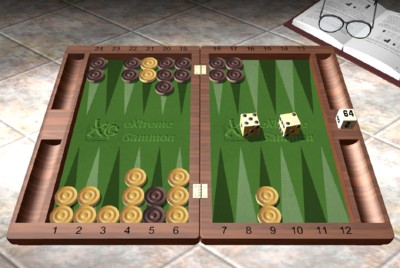Cash game, center cube.

White to play 5-2.
Here we have a position from the tail end of a mutual holding game. These positions typically arise as follows:
> Both sides make an advanced anchor in the opening.
> Both sides bring down some builders from the midpoint and make a few blockading points.
Neither side ever rolls a big double that would allow it to escape the back men safely.
>Both sides slowly dismantle their blocking points and build inner board points behind the opponent’s anchor.
> Crunch time! Both sides start to face tricky decisions about when to leave the anchor.
In this position we’ve reached crunch time. White has a small lead in the race (99 to 105 before the roll), but it’s not hugely significant. If he runs with 21/14, Black can attack the checker he leaves behind on the 21-point. If he doesn’t run, he has to either dismantle his last blocking point (9/4 9/7) or kill some builders in his inner board (6/1 3/1 or 6/1 4/2). At crunch time, you’re usually faced with a bunch of unappealing choices, and you’re looking for the least-bad play. It’s dirty work, but you have to do it.
Let’s list a few general guidelines for this sort of position, and see if they point us in any clear direction. Sometimes they do, but often they don’t.
(1) If you can escape your back checkers cleanly, do it. This is the easiest case. If White rolled 6-5, for instance, it’s massively correct to play 21/15 21/16. Nothing else is close.
(2) Being way ahead in the race is an argument for running. This is a pretty obvious point, but you need to be way ahead for this point to matter much. Here White will lead by 13 pips if he runs – not enough to be decisive.
(3) The better your opponent’s attacking position, the more you want to keep the anchor as long as you can. The is usually the crucial factor. A “bad” attacking position has stacked points or a weak inner board with blots. A “good” attacking position has many pointing numbers plus an absence of inner board points. Here Black’s attacking position is very good. If White runs, Black has 10 immediate pointing numbers (4-3, 4-1, 3-1, 4-4, 3-3, 2-2, and 1-1) plus three more hits in the outfield (6-4 and 5-5). In addition, all the rest of his ones, threes, and fours hit loose, putting White in an immediately critical position. Black’s only bad numbers are 6-5, 6-2, and 5-2, and even these aren’t disasters.
(4) Having useful waiting moves is a strong argument for staying. What makes this a good problem is that White is actually out of useful waiting moves. If he doesn’t run, he’s got to either kill checkers or break his last outfield point, leaving a shot.
(5) If the only alternative is breaking your home board, running is likely to be right. This idea is important but doesn’t come into play here.
(6) When in doubt, keep the anchor. If running is a mistake, it’s liable to be a big mistake. Staying, however, is rarely a big error.
The key consideration here is (3). Black’s attacking structure is ideal. He has no stacks and no blots in his inner board. But if White doesn’t expose himself this turn, Black will almost certainly have to weaken his structure in some way next turn, after which White can run to better effect. For now, we have to discard 21/14.
We also have to discard 9/4 9/7. The 9-point is a great asset, leaving a blot is a bad idea, and leaving a blot exposed to a deuce is especially bad since deuces don’t play well for Black on his side.
With those two plays out of the way, we’re reduced to 6/1 3/1 or 6/1 4/2. Here 4/2 is the right deuce, leaving the 3-point slotted. This gives White a chance to make a 5-point board with a subsequent six, and a stronger board will be a big asset in the later stages of this game.
A final point in favor of our play is that it holds off the cube! Black has a strong double after 21/14 (but it’s still a take), a slightly correct double after 9/4 9/7, and no double after either 6/1 3/1 or 6/1 4/2.





